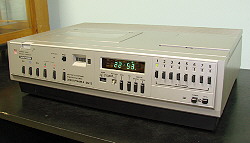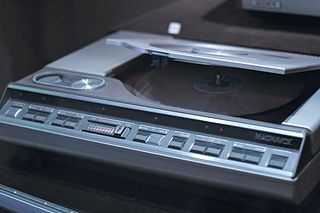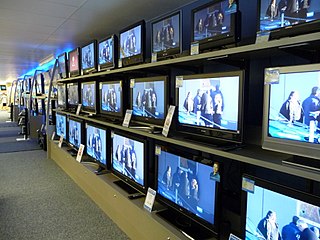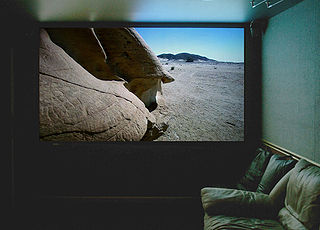 W
WIn electronics, a distribution amplifier, or simply distribution amp or DA, is a device that accepts a single input signal and provides this same signal to multiple isolated outputs.
 W
WA Combo television unit, or a TV/VCR combo, sometimes known as a televideo, is a television with a VCR, DVD player, or sometimes both, built into a single unit. These converged devices have the advantages of saving space and increasing portability. Such units entered the market during the mid-to-late 1980s when VCRs had become ubiquitous household devices. By this time, the VHS format had become standard; thus the vast majority of TV/VCR combos are VHS-based.
 W
WA composite monitor is any analog video display that receives input in the form of an analog composite video signal to a defined specification. A composite video signal encodes all information on a single conductor; a composite cable has a single live conductor plus earth. Other equipment with display functionality includes monitors with more advanced interfaces and connectors giving a better picture, including analog VGA, and digital DVI, HDMI, and DisplayPort; and television (TV) receivers which are self-contained, receiving and displaying video RF broadcasts received with an internal tuner. Video monitors are used for displaying computer output, closed-circuit television and other applications requiring a two-dimensional monochrome or colour image.
 W
WA display device is an output device for presentation of information in visual or tactile form. When the input information that is supplied has an electrical signal the display is called an electronic display.
 W
WA DVD player is a device that plays DVDs produced under both the DVD-Video and DVD-Audio technical standards, two different and incompatible standards. Some DVD players will also play audio CDs. DVD players are connected to a television to watch the DVD content, which could be a movie, a recorded TV show, or other content.
 W
WElektronika VM-12 was the first Soviet VHS-compatible videocassette recorder. It was capable to record SECAM-IIIB D/K (OIRT), PAL and black-and-white video on a 12,65-mm wide magnetic tape.
 W
WThe Flip Video cameras are an American series of tapeless camcorders for digital video created by Pure Digital Technologies, a company bought by Cisco Systems in March 2009; variants included the UltraHD, the MinoHD, and the SlideHD. Flip Video cameras were known for their simple interface with few buttons, minimal menus and built in USB plugs, and were marketed as making video "simple to shoot, simple to share" Production of the line of Flip video cameras ran from 2006 until April 2011, when Cisco Systems discontinued them as part of a move to "...exit aspects of (their) consumer businesses." Flip cameras contributed to an increase in the popularity of similar pocket camcorders, although the inclusion of HD video cameras in many smartphones has since made them a more niche product.
 W
WA LaserDisc player is a device designed to play video (analog) and audio stored on LaserDisc. LaserDisc was the first optical disc format marketed to consumers; it was introduced by MCA DiscoVision in 1978.
 W
WLumus is an Israeli-based Augmented Reality company headquartered in Ness Ziona, Israel. Founded in 2000, Lumus has developed technology for see-through wearable displays, via its patented Light-guide Optical Element (LOE) platform to market producers of smart glasses and augmented reality eyewear. Lumus' technology enables a small natural looking form factor, wide field of view and true see-through performance.
 W
WThe MineCam is a remote exploration camera built by I.A.Recordings. It is used for mine shaft exploration and other similar environments. It was originally conceptualized in 1988, and since went under several design revisions. The name MineCam, is a pun on MiniCam, an early hand-held broadcast camera built by CBS Laboratories.
 W
WA network video recorder (NVR) is a specialized computer system that includes a software program that records video in a digital format to a disk drive, USB flash drive, SD memory card or other mass storage device. An NVR contains no dedicated video capture hardware. However, the software is typically run on a dedicated device, usually with an embedded operating system. Alternatively, to help support increased functionality and serviceability, standard operating systems are used with standard processors and video management software. An NVR is typically deployed in an IP video surveillance system.
 W
WA portable DVD player is a mobile, battery powered DVD player in the format of a mobile device. Many recent players play files from USB flash drives and SD cards.
 W
WAn RF modulator is an electronic device whose input is a baseband signal which is used to modulate a radio frequency source.
Spirit DataCine is a telecine and/or a motion picture film scanner. This device is able to transfer 16mm and 35mm motion picture film to NTSC or PAL television standards or one of many High-definition television standards. With the data transfer option a Spirit DataCine can output DPX data files. The image pick up device is a solid state charge-coupled device. This eliminated the need for glass vacuum tube CRTs used on older telecines. The units can transfer negative film, primetime, intermediate film and print film, stock. One option is a Super 8 gate for the transfer of Super 8 mm film. With a sound pick up option, optical 16mm and 35mm sound can be reproduced, also 16mm magnetic strip sound. The unit can operate stand alone or be controlled by a scene by scene color corrector. Ken Burns created The Civil War, a short documentary film included in the DVD release, on how he used the Spirit DataCine to transfer and remaster this film. The operator of the unit is called a Colorist or Colorist Assistant. The Spirit DataCine has become the standard for high-end real-time film transfer and scanning. Over 370 units are used in post production facilities around the world. Most current film productions are transferred on Spirit DataCines for TV, Digital television, Cable television, Satellite television, Direct-to-video, DVD, Blu-ray Disc, pay-per-view, In-flight entertainment, Stock footage, Dailies, Film preservation, digital intermediate and digital cinema. The Spirit DataCine is made by DFT Digital Film Technology GmbH in Darmstadt, Germany.
 W
WTelevision (TV), sometimes shortened to tele or telly, is a telecommunication medium used for transmitting moving images in monochrome, or in color, and in two or three dimensions and sound. The term can refer to a television set, a television show, or the medium of television transmission. Television is a mass medium for advertising, entertainment, news, and sports.
 W
WTwisted pair cabling is a type of wiring in which two conductors of a single circuit are twisted together for the purposes of improving electromagnetic compatibility. Compared to a single conductor or an untwisted balanced pair, a twisted pair reduces electromagnetic radiation from the pair and crosstalk between neighboring pairs and improves rejection of external electromagnetic interference. It was invented by Alexander Graham Bell.
 W
WA video projector is an image projector that receives a video signal and projects the corresponding image on a projection screen using a lens system. Video projectors use a very bright Ultra-high-performance lamp, Xenon arc lamp, LED or solid state blue, RB, RGB or remote fiber optic RGB lasers to provide the illumination required to project the image, and most modern ones can correct any curves, blurriness, and other inconsistencies through manual settings. If a blue laser is used, a phosphor wheel is used to turn blue light into white light, which is also the case with white LEDs. A wheel is used in order to prolong the lifespan of the phosphor, as it is degraded by the heat generated by the laser diode. Remote fiber optic RGB laser racks can be placed far away from the projector, and several racks can be housed in a single, central room. Each projector can use up to two racks, and several monochrome lasers are mounted on each rack, the light of which is mixed and transmitted to the projector booth using optical fibers. Projectors using RB lasers use a blue laser with a phosphor wheel in conjunction with a conventional solid state red laser.
 W
WA video wall is a special multi-monitor setup that consists of multiple computer monitors, video projectors, or television sets tiled together contiguously or overlapped in order to form one large screen. Typical display technologies include LCD panels, Direct View LED arrays, blended projection screens, Laser Phosphor Displays, and rear projection cubes. Jumbotron technology was also previously used. Diamond Vision was historically similar to Jumbotron in that they both used cathode-ray tube (CRT) technology, but with slight differences between the two. Early Diamond vision displays used separate flood gun CRTs, one per subpixel. Later Diamond vision displays and all Jumbotrons used field-replaceable modules containing several flood gun CRTs each, one per subpixel, that had common connections shared across all CRTs in a module; the module was connected through a single weather-sealed connector.
 W
WA videocassette recorder (VCR) or video recorder is an electromechanical device that records analog audio and analog video from broadcast television or other source on a removable, magnetic tape videocassette, and can play back the recording. Use of a VCR to record a television program to play back at a more convenient time is commonly referred to as timeshifting. VCRs can also play back prerecorded tapes. In the 1980s and 1990s, prerecorded videotapes were widely available for purchase and rental, and blank tapes were sold to make recordings.